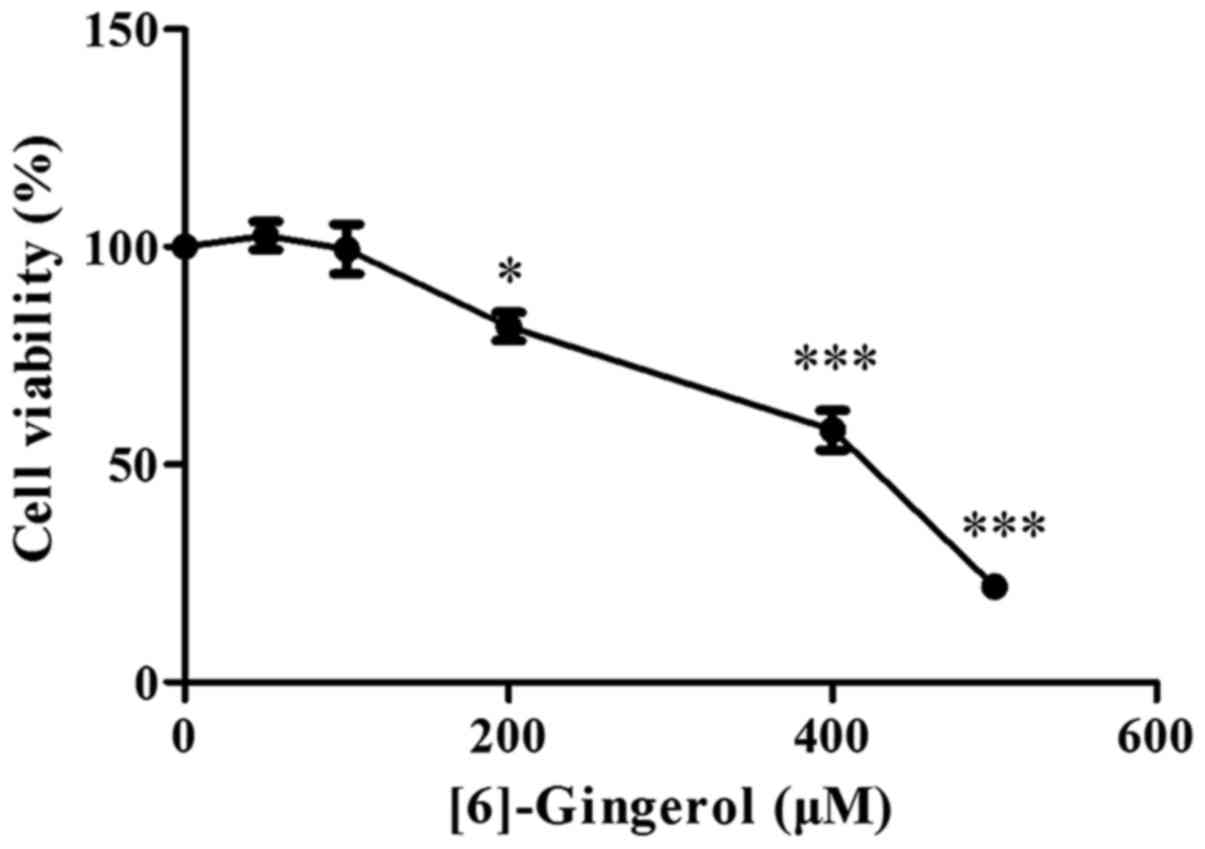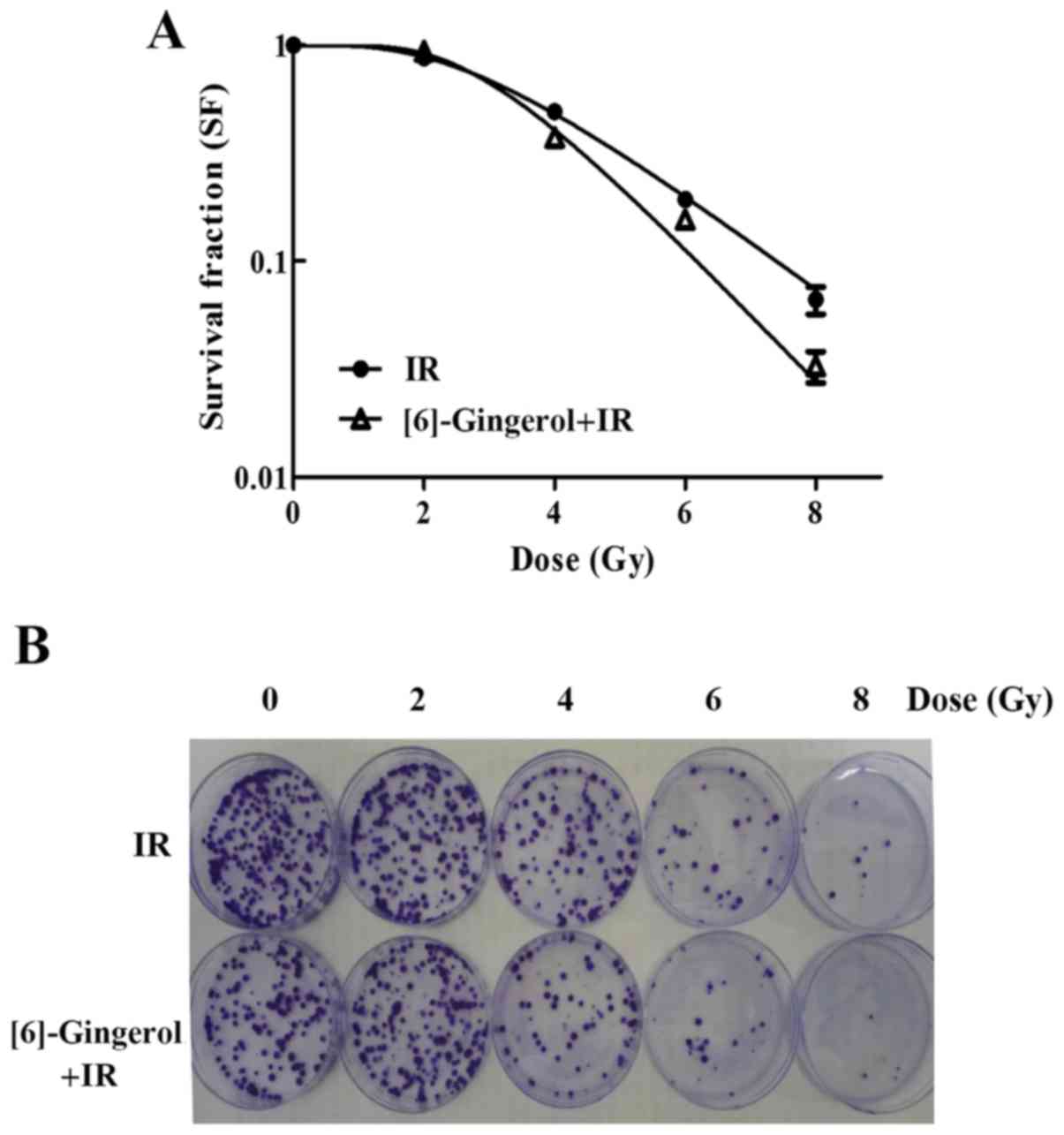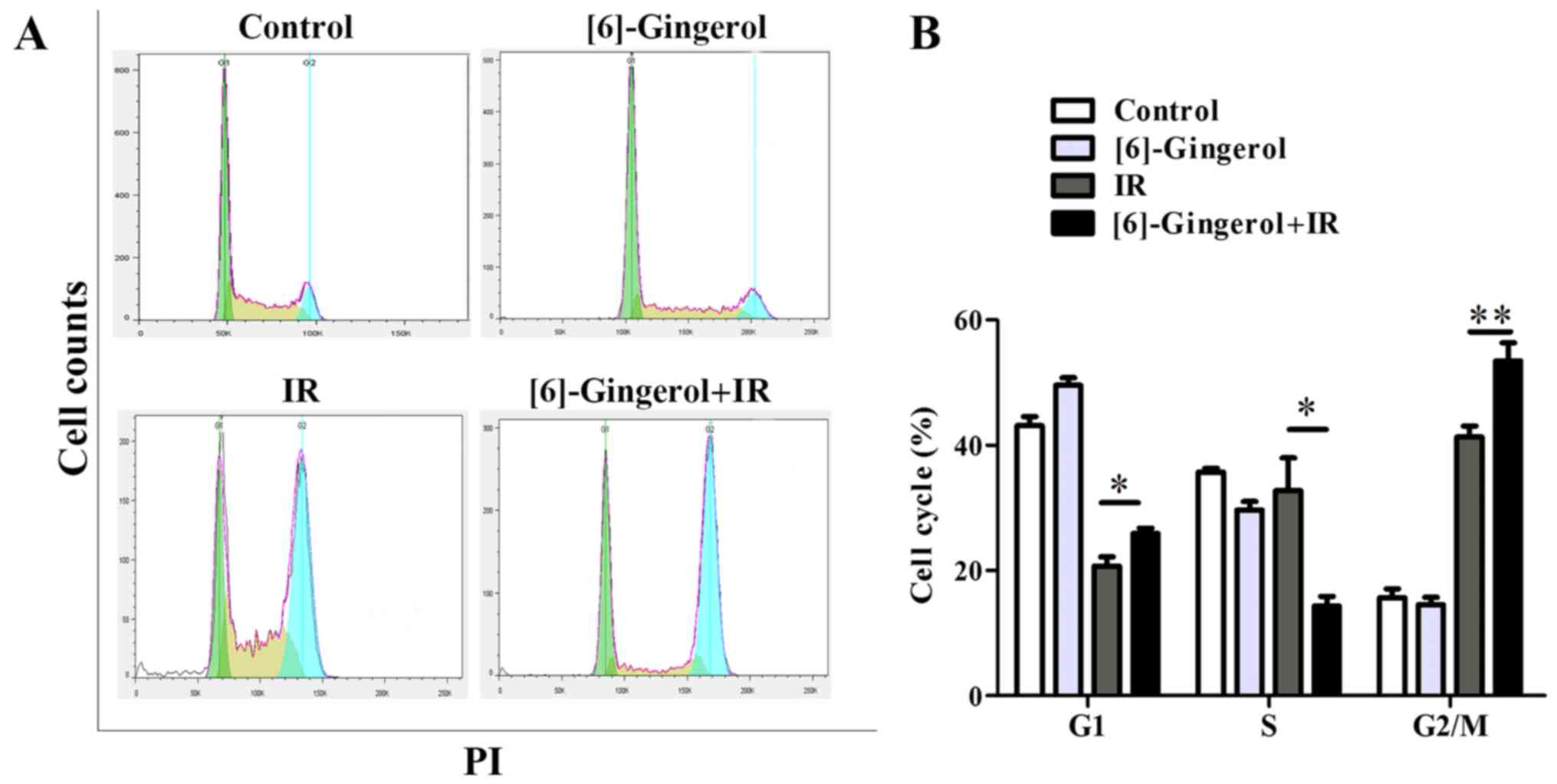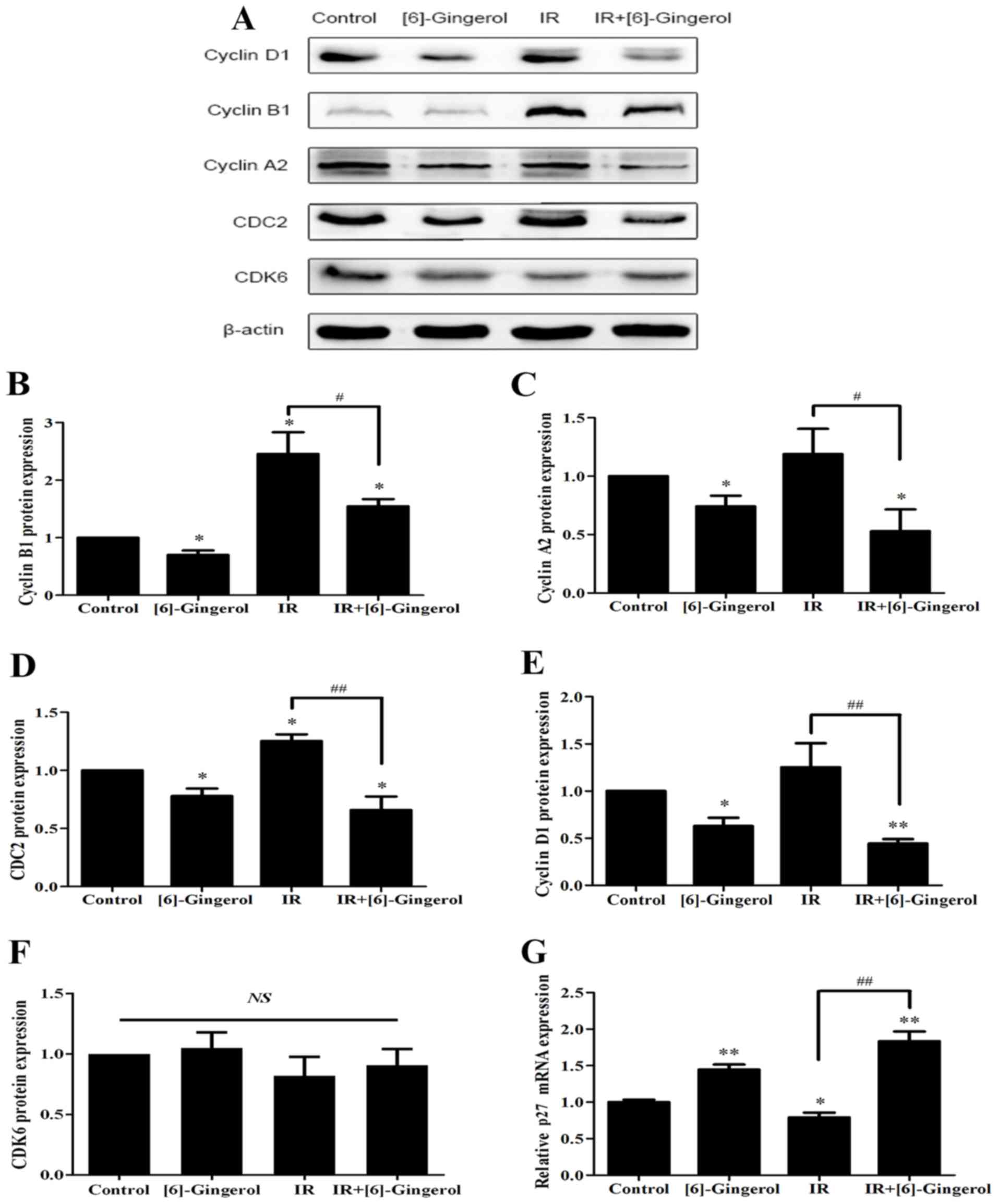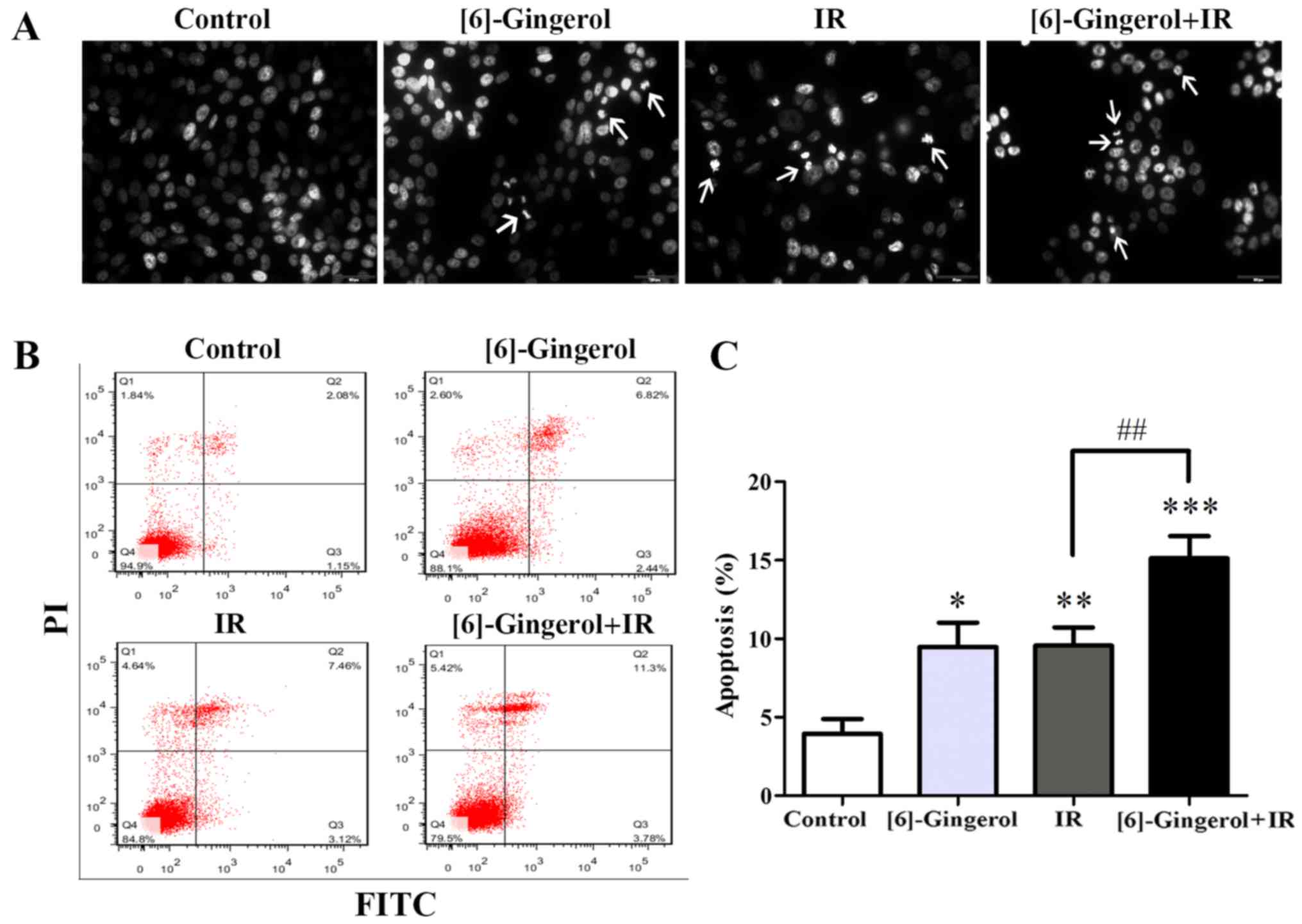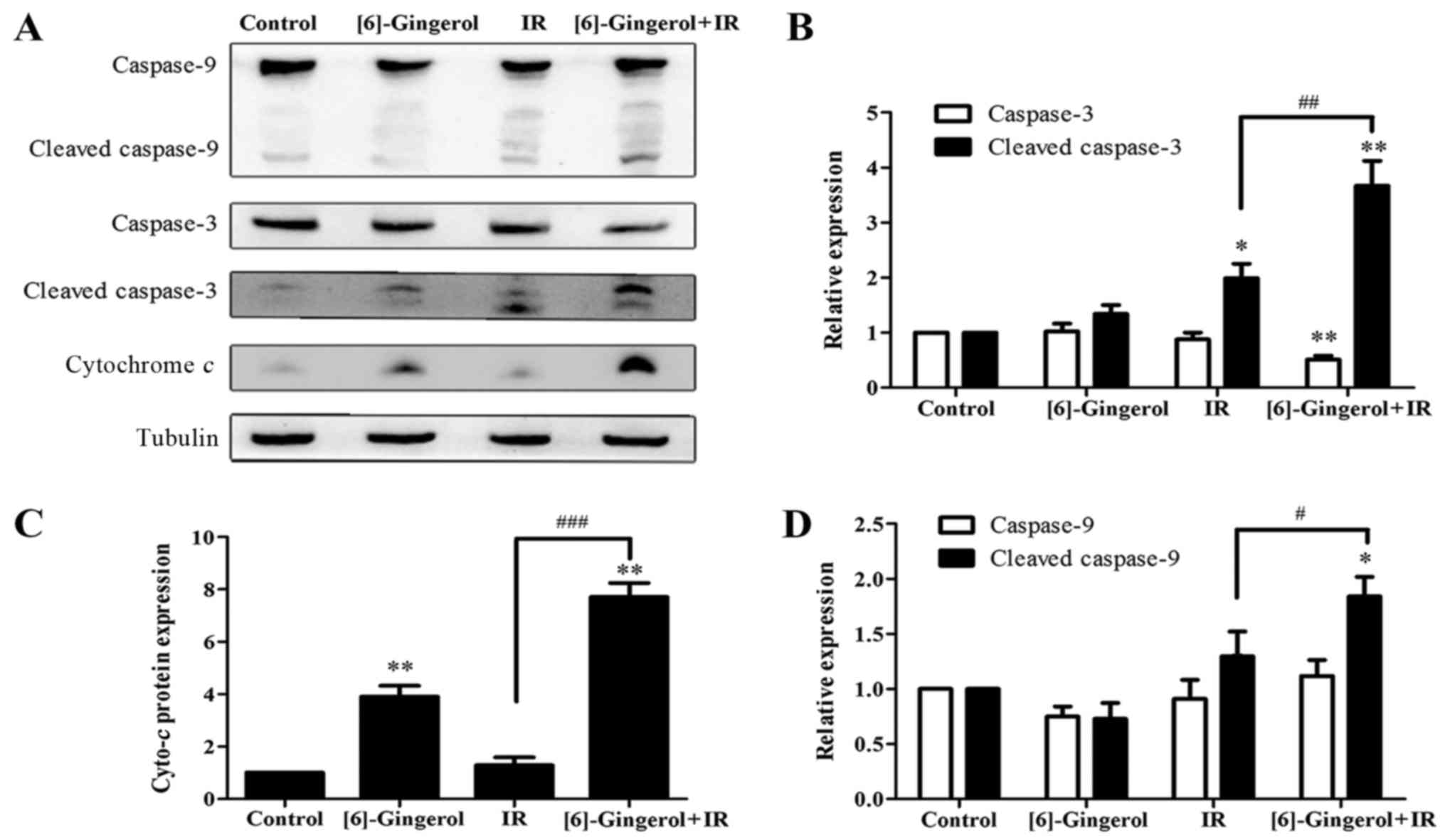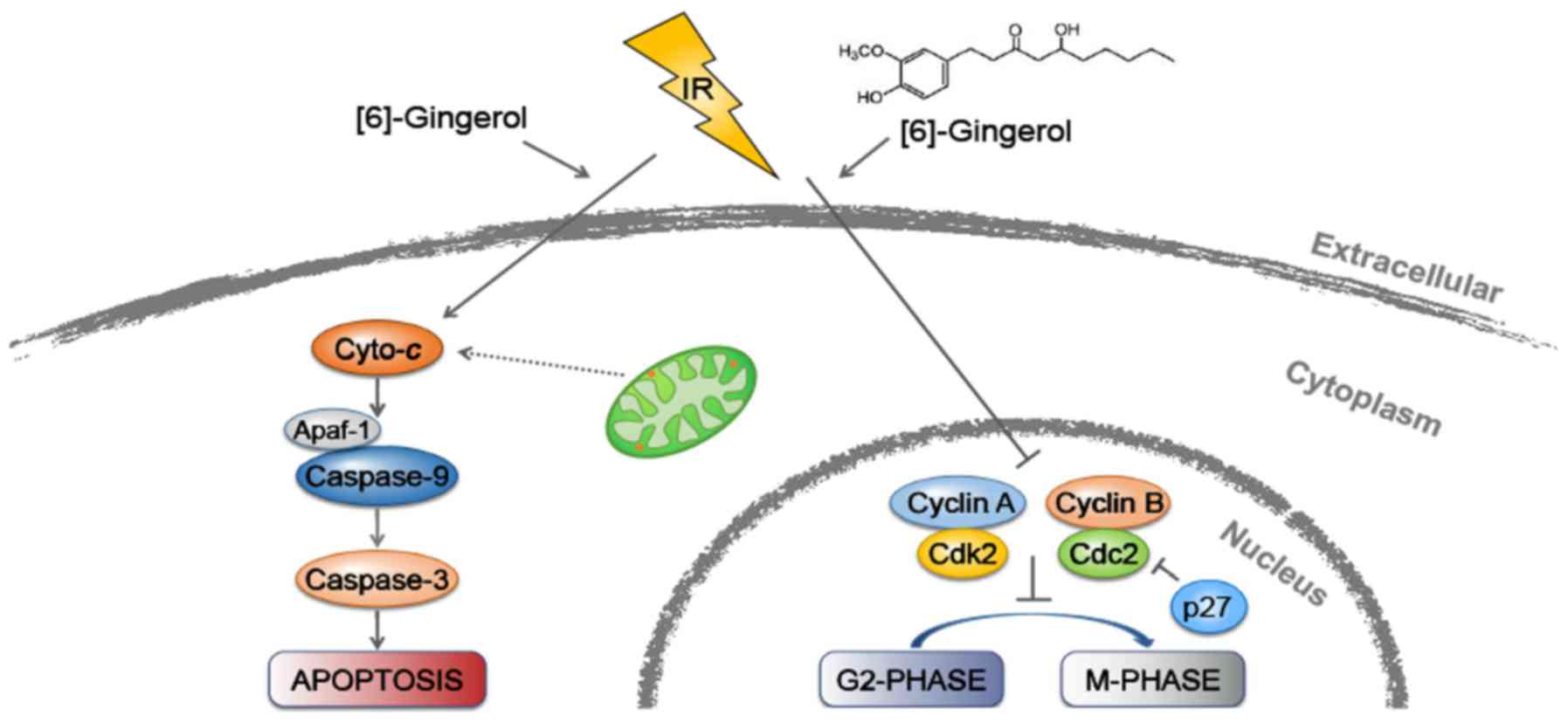[6]-Gingerol enhances the radiosensitivity of gastric cancer via G2/M phase arrest and apoptosis induction
- Authors:
- Published online on: March 5, 2018 https://doi.org/10.3892/or.2018.6292
- Pages: 2252-2260
Abstract
Introduction
Gastric cancer (GC) is the second leading cause of cancer mortality and the fifth most common type of cancer, imposing a serious health burden for the whole world. It is estimated that there were 951,600 new cases and 723,100 deaths in 2012 (1,2). Despite multimodal therapies for GC including surgery, chemotherapy and ionizing radiation (IR), the prognosis of GC remains dismal (3,4), which is mainly due to the advanced stage at diagnosis and the high rate of recurrence. Due to the complexity of GC, complementary therapies are required to improve the efficacy of conventional approaches and the survival of GC patients (5). Radiotherapy plays an important role in management of unresectable GC. It is a critical component of adjuvant therapy for GC after surgical resection, and considered as palliative treatment for relieving local symptoms of locally advanced GC patients (6,7). However, during the IR procedure in the treatment of GC, surrounding organs such as the kidneys, liver, and spleen also receive irradiation that could lead to toxicity, which limits the efficacy of radiotherapy in GC (8,9). Therefore, it is essential to explore effective radiosensitizers to enhance the IR response and reduce the IR toxicity in GC.
Phytochemicals have become a promising approach in the management of malignancies (10,11). [6]-Gingerol, an active phenolic compound derived from ginger, possesses pharmacological activities including anti-inflammatory, antioxidant, and antitumor properties (12,13). In vivo and in vitro studies revealed that [6]-gingerol was effective in the suppression of carcinogenesis, angiogenesis and metastasis against various types of cancer (14–18). However, the chemopreventive effects of [6]-gingerol on GC have not been fully elucidated. To the best of our knowledge, there is no evidence on the radiosensitivity effect and the underlying mechanisms of [6]-gingerol. Therefore, in the present study we aimed to investigate whether [6]-gingerol can sensitize GC cells to IR.
Materials and methods
Cell lines and cell culture
The HGC-27 cell line was obtained from the Cell Bank of the Chinese Academy of Sciences (Shanghai, China). Cells were maintained in a T-25 flask with RPMI-1640 (Gibco, Grand Island, NY, USA), supplemented with 1% penicillin streptomycin (Nanjing KeyGen Biotech Co., Ltd., Nanjing, China) and 10% fetal bovine serum (FBS; Gibco). The cells were incubated at 37°C, in a 5% CO2 humidified incubator.
Chemicals and reagents
[6]-Gingerol (≥98% purity) was purchased from Sichuan Weikeqi Biological Technology Co., Ltd. (Sichuan, China). It was dissolved in DMSO as stock solutions (500 mM) and stored at −20°C. For every experiment, [6]-gingerol was diluted in complete cell culture medium to indicated concentrations, with a final DMSO concentration under 0.1% (v/v). Primary antibodies against cyclin B1 (cat. no. 55004-1-AP), CDK6 (cat. no. 14052-1-AP), β-actin (cat. no. HRP-60008) and tubulin (cat. no. HRP-66031) were purchased from ProteinTech Group, Inc. (Chicago, IL, USA). Antibodies against caspase-9 (cat. no. 9502), caspase-3 (cat. no. 9665), cleaved caspase-3 (Asp175) (cat. no. 9664), cytochrome c (cat. no. 4280), cyclin A2 (cat. no. 4656), CDC2 (cat. no. 77055) and cyclin D1 (cat. no.2978) were purchased from Cell Signaling Technology, Inc. (Beverly, MA, USA). HRP-conjugated goat anti-rabbit IgG (cat. no. HSA0003) and HRP-conjugated goat anti-mouse IgG (cat. no. HSA0001) were obtained from Mai Bio Co., Ltd. (Shanghai, China).
Cell viability assay
The effect of [6]-gingerol on cell viability of human HGC-27 cells was assessed with Cell Counting Kit-8 (CCK-8; Dojindo Molecular Technologies, Inc., Kumamoto, Japan) according to the manufacturer's instructions. Briefly, cells were seeded in 96-well plates at 5×103 cells/well in three replicates and incubated for 24 h. The medium was removed and the cells were exposed to [6]-gingerol (50, 100, 200, 400 and 500 µM) or vehicle (0.1% DMSO) for 48 h. Then 10 µl of CCK-8 solution was added to each well and incubated at 37°C for 1–4 h. The absorbance was assessed at 450 nm using a microplate reader (BioTek Instruments, Inc., Winooski, VT, USA). The viable ratio was presented compared to the vehicle controls (100% active).
Colony formation assay
Cells (2×105) were distributed in 6-well plates and allowed to adhere for 24 h. Then, the cells were treated with vehicle control or [6]-gingerol (300 µM) for 24 h, followed by exposure to different doses of IR. Cells were harvested, counted and 500 cells of each treatment were seeded into a 60-mm culture dish with fresh complete culture medium. Following 10–14 days of incubation, the colonies were stained with crystal violet staining solution (Beyotime Institute of Biotechnology, Shanghai, China). The plates were pictured using a digital camera, and the surviving colonies (colonies containing more than 50 cells under a microscope in ×100 magnification) were counted by Adobe Photoshop CS6 (Adobe, San Jose, CA, USA). Cell survival curves were fitted with the linear-quadratic model using GraphPad Prism 5 software (GraphPad Software, Inc., La Jolla, CA, USA).
Flow cytometric analysis of the cell cycle
Cell cycle distributions were analyzed by assessing the cellular DNA content. Briefly, cells (2×105/well) were seeded onto 6-well plates, allowed to incubate for 24 h, and then the cells were treated with [6]-gingerol (300 µM) or IR (4 Gy) alone or [6]-gingerol (300 µM) for 24 h followed by IR (4 Gy). Twenty-four hours after IR, the culture medium was aspirated and the cells were washed with cold PBS twice and fixed with 70% ethyl alcohol for >2 h. Then, the cells were washed and resuspendented in 0.5 ml PI/RNase Staining Buffer (BD Biosciences, San Jose, CA, USA). After incubation at room temperature for 15 min protected from light, the cells were analyzed by a flow cytometer (BD Biosciences).
DAPI staining
The apoptotic nuclear morphological changes were observed using DAPI staining. Cells (2×105/well) were seeded onto 6-well plates, and were treated with [6]-gingerol (300 µM) or IR (4 Gy) alone or [6]-gingerol (300 µM) for 24 h followed by IR (4 Gy). Twenty-four hours after IR, the cells were washed with PBS and fixed with 4% paraformaldehyde (Nanjing KeyGen Biotech., Co., Ltd.) for 20 min. Fixed cells were washed with PBS, and stained with DAPI (Beyotime Institute of Biotechnology) solution for 10 min in the dark at room temperature, and then the cells were washed with PBS three times. Images were captured using a fluorescence microscope.
Flow cytometric analysis of apoptosis
Apoptosis was analyzed using an Annexin V-FITC/PI Apoptosis Detection kit (BD Biosciences) according to the manufacturer's instructions. In brief, cells (2×105) were plated in 6-well plates and incubated for 24 h. The cells were then treated with [6]-gingerol (300 µM) or IR (4 Gy) alone or [6]-gingerol (300 µM) for 24 h followed by IR (4 Gy), and subsequently, both the floating and the attached cells were collected, stained and analyzed by a flow cytometer (BD Biosciences) for apoptosis 24 h post IR.
RNA extraction and quantitative real time-polymerase chain reaction (qRT-PCR)
Total RNA was extracted using TRIzol (Invitrogen, Carlsbad, CA, USA) and was reverse-transcribed into complementary DNA (cDNA). The sample was subjected to real-time PCR using Real-Time Quantitative PCR SYBR-Green detection reagent (Takara Bio, Inc., Tokyo, Japan) and performed by a Fast 7300 Real-Time PCR system (Applied Biosystems; Thermo Fisher Scientific, Inc., Foster City, CA, USA) according to the manufacturer's instructions. The primer sequences for p27 and β-actin were as follows: p27 forward, 5′-CAAATGCCGGTTCTGTGGAG-3′ and reverse, 5′-TCCATTCCATGAAGTCAGCGATA-3′; β-actin forward, 5′-CATTGCCGACAGGATGCAG-3′ and reverse, 5′-CTCGTCATACTCCTGCTTGCTG-3′.
Western blot analysis
Cells were washed with cold PBS, and lysed in SDS Lysis Buffer containing protease inhibitors PMSF (all from Beyotime Institute of Biotechnology). The whole cell lysate was centrifuged at 18,000 × g for 20 min at 4°C, and the protein concentration was quantified by the BCA assay (Mai Bio Co., Ltd.). Twenty micrograms of whole cell lysate was separated on a 12% SDS-PAGE, and then transferred onto PVDF membranes (EMD Millipore, Billerica, MA, USA). The membranes were probed with primary antibodies against cyclin A2 (1:2,000), cyclin B1 (1:3,000), CDC2 (1:3,000), CDK6 (1:3,000), cyclin D1 (1:2,000), capase-9 (1:3,000), caspase-3 (1:3,000), cleaved caspase-3 (1:2,000) and cytochrome c (1:2,000) at 4°C overnight, followed by incubation with HRP-conjugated secondary antibodies (1:5,000) for 1 h at room temperature. The bands were visualized using ECL (EMD Millipore).
Statistical analysis
SPSS 23.0 (SPSS, Inc., Chicago, IL, USA) was used for statistical analysis. All the experiments were performed three times or more. The data were presented as the mean ± SD and error bars represent the standard deviation. The statistical analysis of compared groups was assessed using Student's t-test. The symbols *, ** and *** represent P-values, and P<0.05 was considered to indicate a statistically significant difference.
Results
[6]-Gingerol inhibits the proliferation of HGC-27 cells
To evaluate the effect of [6]-gingerol on the proliferation of human GC cell line HGC-27 cells, HGC-27 cells were exposed to increasing concentrations of [6]-gingerol or vehicle (0.1% dimethyl sulfoxide) for 48 h and then analyzed using a CCK-8 kit. As shown in Fig. 1, [6]-gingerol reduced the viability of HGC-27 cells in a dose-dependent manner, and the half-maximal inhibitory concentration (IC50) value at 48 h was 386.3 µM.
[6]-Gingerol sensitizes HGC-27 cells to IR
To determine the radiosensitivity of [6]-gingerol in HGC-27 cells, a clonogenic survival assay was performed. A concentration below the IC50 value was chosen for this assay. Cells were pretreated with [6]-gingerol (300 µM) or vehicle for 24 h before being exposed to IR treatment. As shown in Fig. 2A and B, we found that [6]-gingerol sensitized HGC-27 cells to IR. Survival fractions (SFs) of the combination group at 4, 6 and 8 Gy were decreased from 49.2 to 37.3%, 19.35 to 15.8% and 6.6 to 3.3% respectively, compared with the IR group alone (P<0.05). The mean lethal dose (D0) value was decreased from 1.92 to 1.38 Gy, and the sensitization enhancement ratio (SER) was 1.39. These results revealed that [6]-gingerol enhanced the radiosensitivity of HGC-27 cells.
[6]-Gingerol enhances IR-induced G2/M phase arrest
To investigate the mechanisms by which [6]-gingerol induced the radiosensitization effect in HGC-27 cells, we first examined the effect of [6]-gingerol or IR alone and in combination on the cell cycle progression. Cells were treated with [6]-gingerol (300 µM) or IR (4 Gy), or preincubated with [6]-gingerol (300 µM) for 24 h followed by 4 Gy of IR exposure. Cells were then collected and analyzed by flow cytometry. As shown in Fig. 3A and B, [6]-gingerol alone arrested the cell population at the G1 phase (43.1% in the control vs. 49.5% in [6]-gingerol alone; P=0.005), and decreased the S phase cell proportion (35.7% in the control vs. 29.7% in [6]-gingerol alone; P=0.006), while the G2 phase was not affected (15.7% in the control vs. 14.5% in [6]-gingerol alone; P=0.34). However, when [6]-gingerol was combined with IR, the G2/M phase blocking was significantly enhanced compared with the IR group (41.3% in IR alone vs. 53.5% in [6]-gingerol+IR; P=0.006). The S phase population of the cell cycle was decreased in the combination group compared with the IR group (32.8% in IR vs. 14.3% in [6]-gingerol+IR; P=0.02). Populations in the G2/M phase are known to be more sensitive to IR, while cells in the S phase are relatively resistant to IR, therefore the results imply that the radiosensitization effect of [6]-gingerol on HGC-27 cells may partly be due to the G2/M arrest of the cell cycle.
[6]-Gingerol regulates the levels of IR-induced cell cycle-associated proteins and p27 mRNA expression
To demonstrate the mechanisms underlying the enhanced IR-induced G2/M arrest by [6]-gingerol, we then examined the expression levels of G2/M transition regulators including cyclin B1, cyclin A2, CDC2 and p27. As shown in Fig. 4, we observed that the protein levels of cyclin B1, cyclin A2, and CDC2 were downregulated and p27 mRNA expression was upregulated in the [6]-gingerol+IR group compared with the IR alone group. Since the previous cellular results revealed G1 phase arrest in the combination treatment group, we also investigated G1 phase-associated checkpoints, and determined that cyclin D1 was downregulated however, CDK6 remained unchanged. The data were consistent with the results of the cellular cell distribution analysis.
[6]-Gingerol increases IR-induced apoptosis
We next investigated whether [6]-gingerol could increase IR-induced apoptosis. Cells were treated with vehicle control, [6]-gingerol (300 µM), IR (4 Gy), and [6]-gingerol (300 µM) + IR (4 Gy), and then were stained with DAPI. As shown in Fig. 5A, apoptotic cells with condensed chromatin and fragmented nuclei were clearly visible in both single-treatment of [6]-gingerol or IR and in the combination treatment, but not in the control. Apoptosis was further analyzed by Annexin V/PI-staining. As shown in Fig. 5B and C, [6]-gingerol or IR alone induced apoptosis of HGC-27 cells, and the apoptosis rates were 9.5±1.6 and 9.6%±1.2% respectively, compared with the vehicle control (3.9±1.0%). [6]-Gingerol pretreatment significantly increased IR-induced cell apoptosis compared with IR alone in HGC-27 cells (9.6±1.2% in IR alone vs. 15.1±1.4% in [6]-gingerol+IR; P=0.007). These results revealed that [6]-gingerol increased the apoptosis induction of IR in HGC-27 cells.
[6]-Gingerol enhances the levels and activities of IR-induced apoptosis regulatory proteins
To elucidate the mechanisms of the [6]-gingerol-enhanced IR-induced cell apoptosis, we performed western blot analysis to examine the protein levels of several key regulatory molecules including caspase-9, cleaved-caspase-9, caspase-3, cleaved-caspase-3 and cytochrome c, which are initiators and executors of the apoptotic process. Fig. 6 revealed that the levels of procaspase-9 (47 kDa), and cytochrome c were upregulated in the cells treated with IR or [6]-gingerol alone compared with the control, meanwhile, the cleaved fragments of caspase-9 (35 kDa) were also observed. Procaspase-3 (35 kDa) was decreased and cleaved-caspase-3 (17/19 kDa) was markedly increased in the combination treatment group. Furthermore, the combination treatment of [6]-gingerol with IR was more effective in upregulating those proteins levels compared with either treatment alone. These findings were consistent with the previous flow cytometric data of apoptosis, indicating that [6]-gingerol enhanced IR-induced apoptosis via the activation of caspase-9, caspase-3 and the release of cytochrome c.
Discussion
GC places a big burden on societies due to its high incidence and poor prognosis. Radiotherapy is an important modality for the treatment of GC, however, the efficacy is limited due to the intrinsic and extrinsic IR resistance and toxicity to normal tissues. Existing radiosensitization approaches like combining chemotherapeutic drugs such as cisplatin, 5-fluorouracil with IR can produce synergistic effects but also increase side effects in some cases (19). Therefore, searching for new radiosensitizers is of great importance. Phytochemicals have drawn wide attention as promising radiosensitizers in the course of radiotherapy (20–23). [6]-Gingerol has demonstrated potential chemopreventive ability in various cancer types. For the first time, our study investigated the possibility of [6]-gingerol as a radiosensitizer in GC cells.
In the present study, we first investigated the effect of [6]-gingerol alone on the proliferation of HGC-27 GC cells and determined that [6]-gingerol could inhibit cell viability in a dose-dependent manner. To determine the potential of [6]-gingerol as a radiosensitizer, we next chose [6]-gingerol at 300 µM (<IC50) for a colony formation assay. According to the survival curve, radiobiological parameters were calculated. In the field of radiobiology, the combined therapeutic effects based on drug and ionizing irradiation is obtained by the SFs (24–26). SER is commonly used as a direct reflection of radiosensitivity. SER was calculated by dividing the D0 value of the IR alone group by the D0 value of the combined [6]-gingerol and IR group (the D0 value refers to mean lethal dose). In the present study, at 4, 6 and 8 Gy, the SFs of the combination treatment were decreased compared with IR alone; the D0 value of the combination group was relatively lower suggesting that the reasonable lower doses of X-ray can also kill tumor cells when coupled with [6]-gingerol; the SER was 1.39. Therefore, pretreatment with [6]-gingerol could sensitize HGC-27 cells to IR.
There are several factors that influence IR sensitivity, including the modulation of cell apoptosis, cycle distribution, hypoxia, DNA damage repair and signaling pathways (27–29). G2/M phase is the most radio-sensitive stage of the cell cycle, therefore drugs that can induce G2/M arrest are potential radiosensitizers. Previous studies reported chemotherapeutic agents that enhanced the radiosensitivity of cancer cells by accumulating the G2/M population, such as zerumbone and docetaxel (20,30). [6]-Gingerol was reported to induce cell cycle arrest in various cancers. A study by Rastogi et al reported that [6]-gingerol induced G2/M cell cycle arrest in cervical cancer cells (31), and another study by Lee et al revealed that [6]-gingerol caused cell cycle arrest at the G1 phase in colorectal cancer cells (16). However, the effect of [6]-gingerol on cell cycle distribution of GC cells remains unknown. In the present study, treatment with [6]-gingerol (300 µM) alone arrested cells at the G1 phase, and the alteration of the G2/M phase was slight. Notably, when [6]-gingerol was combined with IR, the G2/M phase [the most radiosensitive stage of the cell cycle (32)] was significantly increased compared to IR alone, with the S phase (relatively resistant to IR) decreased and the G1 phase (less sensitive to IR) increased. Cell cycle progression is primarily regulated by activation of cyclins and cyclin-dependent kinases (Cdks), and inhibition of these checkpoints may have the potential to mediate radiosensitization (33). The cyclin B/CDC2 complex is responsible for the phosphorylation and activation of enzymes that are required for normal mitosis and is considered as a crucial checkpoint for G2 to M phase transition (34). The impairment of the cyclin B/CDC2 complex activity blocked G2/M transition. Cyclin A is also essential for G2 progression (35). The CDK inhibitors (CKIs) are important negative regulators of cell cycle progression. They interact with cyclin/CDK complexes and inhibit their activities. p27, a CDK inhibitor, binds to CDC2 and inhibits its activity (36). In the present study, we analyzed the involved regulatory proteins by western blotting and found that [6]-gingerol decreased cyclin B1, cyclin A2 and CDC2 expression and increased the mRNA expression of p27. Pretreatment with [6]-gingerol before IR exposure downregulated the cell protein levels of cyclin B1, cyclin A2, and CDC2 compared with IR alone. qRT-PCR revealed that the p27 mRNA level was markedly enhanced by the combination treatment, thus we hypothesized that the increase of p27 may contribute to the decrease of CDC2. How p27 interacts with CDC2 and influences its expression is worth studying in the future. Therefore, we suggest that [6]-gingerol enhances IR-induced arrest at the G2/M phase through inhibition of G2/M checkpoints. We also observed G1 phase blocking and an S phase decrease, and the G1 phase was associated with cyclin D1 downregulation. The CDK4/6-cyclin D1 complex is a central checkpoint of G1 progression and G1/S transition (37). Thus, the decrease of cyclin D1 and the resultant G1 arrest may also mediate the radiosensitization of [6]-gingerol in HGC-27 cells.
Apoptosis is a main form of cell death after IR. Radiosensitizers could enhance the therapeutic effect of radiotherapy by inducing apoptosis (38). Previous studies have shown that [6]-gingerol induced apoptosis in various cancer cells through several mechanisms. One study revealed that [6]-gingerol enhanced TRAIL-induced apoptosis but alone inhibited viability only slightly in GC cells (39). Conversely, our study determined that [6]-gingerol alone inhibited cell viability in a dose-dependent manner, and induced apoptosis in GC cells. When combined with IR, [6]-gingerol decreased clonogenic survival and increased IR-induced apoptosis. The two major apoptosis pathways are the extrinsic pathway or death receptor-mediated pathway and the intrinsic pathway or mitochondrial-mediated pathway. In the mitochondrial pathway, cytochrome c is released from the mitochondrial intermembrane into the cytoplasm, which stimulates apoptosis. Then, cytochrome c interacts with Apaf-1, binding and activating caspase-9 proenzymes, an initiator caspase. Caspase-3, a key effector caspase, is activated by active caspase-9, followed by activation of the rest of the caspase cascades and apoptosis induction (40). In the present study, the western blotting results revealed that [6]-gingerol alone increased cleaved capsase-3 and cytochrome c, but the influence on cleaved caspase-9 was not significant. In fact, in addition to caspase-9, caspase-3 can be activated by caspase-8, which plays a role in the extrinsic pathway. Previous studies have reported that [6]-gingerol could sensitize TRAIL-induced apoptotic cancer cell death through caspase-8 and caspase-3 activation (41). These results indicated that [6]-gingerol can induce apoptosis and that the manner in which [6]-gingerol induces and modulates apoptosis is complex, which inspires us to perform more studies in the future. When [6]-gingerol was combined with IR, cleaved caspase-9, cleaved caspase-3 and cytochrome c were markedly increased compared with either [6]-gingerol or IR alone, indicating that [6]-gingerol sensitized HGC-27 GC cells to IR through activation of caspases. Radiation induces DNA damage directly and also generates abnormally elevated ROS, which can cause large amounts of DNA damage, thereby increasing the apoptosis effect of radiation on the tumor (24,42). The present study revealed that [6]-gingerol enhanced IR-induced apoptosis, and cytochrome c, a critical molecule in the mitochondrial-mediated apoptosis pathway, was significantly increased in the combination group, which hinted to possible mitochondrial damage. Yet the specific changes of the mitochondria and through what mechanism these damages can be induced warrant further study in our future research.
In conclusion, as depicted in Fig. 7, our study revealed for the first time that [6]-gingerol could sensitize GC cells to IR. Moreover, we demonstrated that the radiosensitization effect of [6]-gingerol on HGC-27 cells was mediated through induction of G2/M arrest and apoptosis. Recently, the application of natural phytochemicals in cancer control and management has gained general acceptance. [6]-Gingerol is the most abundant bioactive compound of ginger, and it is readily available and inexpensive. Therefore, the use of [6]-gingerol as a radiosensitizer would provide a promising future for GC radiotherapy and bring great benefits for GC patients. To confirm the radiosensitization effect of [6]-gingerol, further studies focusing on the distinct molecular mechanisms, animal experiments and clinical trials are warranted.
Acknowledgements
We thank all the members of our laboratory for their helpful technical support.
References
|
Torre LA, Bray F, Siegel RL, Ferlay J, Lortet-Tieulent J and Jemal A: Global cancer statistics, 2012. CA Cancer J Clin. 65:87–108. 2015. View Article : Google Scholar : PubMed/NCBI | |
|
Global Burden of Disease Cancer Collaboration, . Fitzmaurice C, Dicker D, Pain A, Hamavid H, Moradi-Lakeh M, MacIntyre MF, Allen C, Hansen G, Woodbrook R, Wolfe C, et al: The global burden of cancer 2013. JAMA Oncol. 1:505–527. 2015. View Article : Google Scholar : PubMed/NCBI | |
|
Karimi P, Islami F, Anandasabapathy S, Freedman ND and Kamangar F: Gastric cancer: Descriptive epidemiology, risk factors, screening, and prevention. Cancer Epidemiol Biomarkers Prev. 23:700–713. 2014. View Article : Google Scholar : PubMed/NCBI | |
|
Zhang H, Sun LL, Meng YL, Song GY, Hu JJ, Lu P and Ji B: Survival trends in gastric cancer patients of Northeast China. World J Gastroenterol. 17:3257–3262. 2011.PubMed/NCBI | |
|
Wang CY, Bai XY and Wang CH: Traditional Chinese medicine: A treasured natural resource of anticancer drug research and development. Am J Chin Med. 42:543–559. 2014. View Article : Google Scholar : PubMed/NCBI | |
|
Wong RK, Jang R and Darling G: Postoperative chemoradiotherapy vs. preoperative chemoradiotherapy for locally advanced (operable) gastric cancer: Clarifying the role and technique of radiotherapy. J Gastrointest Oncol. 6:89–107. 2015.PubMed/NCBI | |
|
Pang X, Wei W, Leng W, Chen Q, Xia H, Chen L and Li R: Radiotherapy for gastric cancer: A systematic review and meta-analysis. Tumour Biol. 35:387–396. 2014. View Article : Google Scholar : PubMed/NCBI | |
|
Trip AK, Sikorska K, van Sandick JW, Heeg M, Cats A, Boot H, Jansen EP and Verheij M: Radiation-induced dose-dependent changes of the spleen following postoperative chemoradiotherapy for gastric cancer. Radiother Oncol. 116:239–244. 2015. View Article : Google Scholar : PubMed/NCBI | |
|
Dawson LA, Kavanagh BD, Paulino AC, Das SK, Miften M, Li XA, Pan C, Ten Haken RK and Schultheiss TE: Radiation-associated kidney injury. Int J Radiat Oncol Biol Phys. 76 Suppl:S108–S115. 2010. View Article : Google Scholar : PubMed/NCBI | |
|
Surh YJ: Cancer chemoprevention with dietary phytochemicals. Nat Rev Cancer. 3:768–780. 2003. View Article : Google Scholar : PubMed/NCBI | |
|
Hu XQ, Sun Y, Lau E, Zhao M and Su SB: Advances in synergistic combinations of Chinese herbal medicine for the treatment of cancer. Curr Cancer Drug Targets. 16:346–356. 2016. View Article : Google Scholar : PubMed/NCBI | |
|
Baliga MS, Haniadka R, Pereira MM, D'Souza JJ, Pallaty PL, Bhat HP and Popuri S: Update on the chemopreventive effects of ginger and its phytochemicals. Crit Rev Food Sci Nutr. 51:499–523. 2011. View Article : Google Scholar : PubMed/NCBI | |
|
Oyagbemi AA, Saba AB and Azeez OI: Molecular targets of [6]-gingerol: Its potential roles in cancer chemoprevention. Biofactors. 36:169–178. 2010. View Article : Google Scholar : PubMed/NCBI | |
|
Park KK, Chun KS, Lee JM, Lee SS and Surh YJ: Inhibitory effects of [6]-gingerol, a major pungent principle of ginger, on phorbol ester-induced inflammation, epidermal ornithine decarboxylase activity and skin tumor promotion in ICR mice. Cancer Lett. 129:139–144. 1998. View Article : Google Scholar : PubMed/NCBI | |
|
Weng CJ, Wu CF, Huang HW, Ho CT and Yen GC: Anti-invasion effects of 6-shogaol and 6-gingerol, two active components in ginger, on human hepatocarcinoma cells. Mol Nutr Food Res. 54:1618–1627. 2010. View Article : Google Scholar : PubMed/NCBI | |
|
Lee SH, Cekanova M and Baek SJ: Multiple mechanisms are involved in 6-gingerol-induced cell growth arrest and apoptosis in human colorectal cancer cells. Mol Carcinog. 47:197–208. 2008. View Article : Google Scholar : PubMed/NCBI | |
|
Lee HS, Seo EY, Kang NE and Kim WK: [6]-Gingerol inhibits metastasis of MDA-MB-231 human breast cancer cells. J Nutr Biochem. 19:313–319. 2008. View Article : Google Scholar : PubMed/NCBI | |
|
Kim EC, Min JK, Kim TY, Lee SJ, Yang HO, Han S, Kim YM and Kwon YG: [6]-Gingerol, a pungent ingredient of ginger, inhibits angiogenesis in vitro and in vivo. Biochem Biophys Res Commun. 335:300–308. 2005. View Article : Google Scholar : PubMed/NCBI | |
|
Higgins GS, O'Cathail SM, Muschel RJ and McKenna WG: Drug radiotherapy combinations: Review of previous failures and reasons for future optimism. Cancer Treat Rev. 41:105–113. 2015. View Article : Google Scholar : PubMed/NCBI | |
|
Deorukhkar A, Ahuja N, Mercado AL, Diagaradjane P, Raju U, Patel N, Mohindra P, Diep N, Guha S and Krishnan S: Zerumbone increases oxidative stress in a thiol-dependent ROS-independent manner to increase DNA damage and sensitize colorectal cancer cells to radiation. Cancer Med. 4:278–292. 2015. View Article : Google Scholar : PubMed/NCBI | |
|
Orr WS, Denbo JW, Saab KR, Ng CY, Wu J, Li K, Garner JM, Morton CL, Du Z, Pfeffer LM, et al: Curcumin potentiates rhabdomyosarcoma radiosensitivity by suppressing NF-kB activity. PLoS One. 8:513092013. View Article : Google Scholar | |
|
Liu JS, Che XM, Chang S, Qiu GL, He SC, Fan L, Zhao W, Zhang ZL and Wang SF: β-elemene enhances the radiosensitivity of gastric cancer cells by inhibiting Pak1 activation. World J Gastroenterol. 21:9945–9956. 2015. View Article : Google Scholar : PubMed/NCBI | |
|
Sun M, Pan D, Chen Y, Li Y, Gao K and Hu B: Coroglaucigenin enhances the radiosensitivity of human lung cancer cells through Nrf2/ROS pathway. Oncotarget. 8:32807–32820. 2017.PubMed/NCBI | |
|
Yao JX, Yao ZF, Li ZF and Liu YB: Radio-sensitization by Piper longumine of human breast adenoma MDA-MB-231 cells in vitro. Asian Pac J Cancer Prev. 15:3211–3217. 2014. View Article : Google Scholar : PubMed/NCBI | |
|
Zhang P, Wang L, Rodriguez-Aguayo C, Yuan Y, Debeb BG, Chen D, Sun Y, You MJ, Liu Y, Dean DC, et al: miR-205 acts as a tumour radiosensitizer by targeting ZEB1 and Ubc13. Nat Commun. 5:56712014. View Article : Google Scholar : PubMed/NCBI | |
|
Azad A, Lim Yin S, D'Costa Z, Jones K, Diana A, Sansom OJ, Kruger P, Liu S, McKenna WG, Dushek O, et al: PD-L1 blockade enhances response of pancreatic ductal adenocarcinoma to radiotherapy. EMBO Mol Med. 9:167–180. 2017. View Article : Google Scholar : PubMed/NCBI | |
|
Rey S, Schito L, Koritzinsky M and Wouters BG: Molecular targeting of hypoxia in radiotherapy. Adv Drug Deliv Rev. 109:45–62. 2017. View Article : Google Scholar : PubMed/NCBI | |
|
Berdis AJ: Current and emerging strategies to increase the efficacy of ionizing radiation in the treatment of cancer. Expert Opin Drug Discov. 9:167–181. 2014. View Article : Google Scholar : PubMed/NCBI | |
|
Ding M, Zhang E, He R and Wang X: Newly developed strategies for improving sensitivity to radiation by targeting signal pathways in cancer therapy. Cancer Sci. 104:1401–1410. 2013. View Article : Google Scholar : PubMed/NCBI | |
|
Miyanaga S, Ninomiya I, Tsukada T, Okamoto K, Harada S, Nakanuma S, Sakai S, Makino I, Kinoshita J, Hayashi H, et al: Concentration-dependent radiosensitizing effect of docetaxel in esophageal squamous cell carcinoma cells. Int J Oncol. 48:517–524. 2016. View Article : Google Scholar : PubMed/NCBI | |
|
Rastogi N, Duggal S, Singh SK, Porwal K, Srivastava VK, Maurya R, Bhatt ML and Mishra DP: Proteasome inhibition mediates p53 reactivation and anti-cancer activity of 6-gingerol in cervical cancer cells. Oncotarget. 6:43310–43325. 2015. View Article : Google Scholar : PubMed/NCBI | |
|
Dillon MT, Good JS and Harrington KJ: Selective targeting of the G2/M cell cycle checkpoint to improve the therapeutic index of radiotherapy. Clin Oncol (R Coll Radiol). 26:257–265. 2014. View Article : Google Scholar : PubMed/NCBI | |
|
Yan Y, Black CP and Cowan KH: Irradiation-induced G2/M checkpoint response requires ERK1/2 activation. Oncogene. 26:4689–4698. 2007. View Article : Google Scholar : PubMed/NCBI | |
|
Smits VA and Medema RH: Checking out the G(2)/M transition. Biochim Biophys Acta. 1519:1–12. 2001. View Article : Google Scholar : PubMed/NCBI | |
|
Furuno N, den Elzen N and Pines J: Human cyclin A is required for mitosis until mid prophase. J Cell Biol. 147:295–306. 1999. View Article : Google Scholar : PubMed/NCBI | |
|
Payne SR, Zhang S, Tsuchiya K, Moser R, Gurley KE, Longton G, deBoer J and Kemp CJ: p27kip1 deficiency impairs G2/M arrest in response to DNA damage, leading to an increase in genetic instability. Mol Cell Biol. 28:258–268. 2008. View Article : Google Scholar : PubMed/NCBI | |
|
Deng M, Zeng C, Lu X, He X, Zhang R, Qiu Q, Zheng G, Jia X, Liu H and He Z: miR-218 suppresses gastric cancer cell cycle progression through the CDK6/Cyclin D1/E2F1 axis in a feedback loop. Cancer Lett. 403:175–185. 2017. View Article : Google Scholar : PubMed/NCBI | |
|
Kim BM and Hong Y, Lee S, Liu P, Lim JH, Lee YH, Lee TH, Chang KT and Hong Y: Therapeutic implications for overcoming radiation resistance in cancer therapy. Int J Mol Sci. 16:26880–26913. 2015. View Article : Google Scholar : PubMed/NCBI | |
|
Ishiguro K, Ando T, Maeda O, Ohmiya N, Niwa Y, Kadomatsu K and Goto H: Ginger ingredients reduce viability of gastric cancer cells via distinct mechanisms. Biochem Biophys Res Commun. 362:218–223. 2007. View Article : Google Scholar : PubMed/NCBI | |
|
Ghobrial IM, Witzig TE and Adjei AA: Targeting apoptosis pathways in cancer therapy. CA Cancer J Clin. 55:178–194. 2005. View Article : Google Scholar : PubMed/NCBI | |
|
Lee DH, Kim DW, Jung CH, Lee YJ and Park D: Gingerol sensitizes TRAIL-induced apoptotic cell death of glioblastoma cells. Toxicol Appl Pharmacol. 279:253–265. 2014. View Article : Google Scholar : PubMed/NCBI | |
|
Zhang B, Wang Y and Su Y: Peroxiredoxins, a novel target in cancer radiotherapy. Cancer Lett. 286:154–160. 2009. View Article : Google Scholar : PubMed/NCBI |



